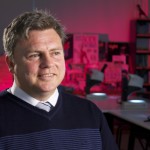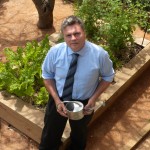 Matthew McCloskey
Matthew McCloskey
Matthew McCloskey is in the vanguard of the renaissance of primary science teaching in Australia—bringing real science experiments back into the classroom, building on his own experience as a research scientist and zoologist.
At Sydney Grammar’s Edgecliff Preparatory School he and a colleague teach science to every student from kindergarten to Year six at least once a week. He has learnt what it takes to deliver a great science class, and he is sharing this in his writing for the national science curriculum and in his support of his peers.
For his leadership in primary science teaching, Matthew McCloskey receives the 2010 Prime Minister’s Prize for Excellence in Science Teaching in Primary Schools.
As a PhD student and working research scientist Matthew McCloskey realised that most of his science colleagues traced their passion for science to back to good teaching at primary school. That realisation triggered a change in direction. “My earliest childhood memory is of catching ladybirds in a rose bush,” Matthew says. And he spent hours in the bush chasing lizards.
Those early experiences started a lifelong interest in zoology. It led to a zoology degree at the University of Sydney and honours, looking at the energetics and locomotion in hopping marsupials. Then to a Masters and PhD in animal and human physiology.
“I met many very good scientists who traced their passion for science to early childhood and primary school. And for me, that confirmed the truism: show me the child before they are seven, and I’ll show you the person,” he says.
Matthew turned to teaching and, for the last thirteen years, has taught at Edgecliff.

How can you identify a good science class? Matthew says you can see it in the activity: children working on their own, confident enough to be sceptical about the results they are collecting themselves and, in the process, forming valuable opinions about science itself.
“In my classes the children do science. We set out to investigate. Students are coming up with their own questions, designing their own experiments, making observations and interpreting and drawing conclusions.”
Some of his initiatives include:
- A wind tunnel: students study the aerodynamics of flying objects testing gliders in a wind tunnel, and launching them from a helium balloon;
- Collectors: Year 3 students are given a collection box—to collect and curate objects they find, such as shells, flowers, electronic components or minerals;
- The urban zoologists: students study the native and introduced animals in and around the school and coax native species back with nest boxes for bats, birds and possums;
- The urban gardeners: students develop a community garden which introduces them to sustainable living—managing water, germinating and nurturing their plants. “We hope they’ll go back home and do the same things in their own backyards,” says Matthew.
Matthew’s longstanding interest in amphibians and reptiles sees him still active as a volunteer—with the Australian Museum and doing fieldwork at Olympic Park. And it gives him the chance to bring reptiles into the classroom and introduce them to inner city students.
Matthew feels primary teaching has hit a bit of a low in recent years. What’s wrong? He says that many primary teachers don’t feel confident in the science classroom, due to their own experiences of science in school. And the curriculum is too crowded.
“We need to give teachers more confidence. Many teachers are too quick to teach history and geography in preference to science because they feel it is easier,” he says.
But he believes the future is bright. “I’ve been contributing to the first national curriculum in science. That will help. The great resources that the Academy of Science is putting together for the Primary Connections Program will help. So the framework will be there.”
“But we need good professional development and resources to back up this investment. Teachers are professional so if we give them good support they will pick it up and work with it. We need to give them the resources and acknowledge that the curriculum is too crowded.”
Matthew’s doing his own bit with these initiatives. He also worked with the Early Childhood Council in NSW, convenes the NSW science teachers’ conference and works closely with neighbouring schools to encourage science teachers.
What’s in Matthew’s future? “I’m a primary teacher through and through, so I’ll be staying in the classroom,” he says.
“It’s all about seeing the lights turn on. Satisfaction comes from seeing children develop an interest in science.”
Qualifications
| 2001 | PhD (Medical science), University of New South Wales, Sydney |
| 1993 | Diploma of Education (Primary), University of Sydney |
| 1991 | Bachelor of Science (Honours), University of New South Wales, Sydney |
| 1990 | Bachelor of Science, University of Sydney |
Career highlights, awards, fellowships and grants
| 2002-present | Director of Studies, Sydney Grammar Edgecliff Preparatory School |
| 1999-present | Head of Science and Technology Department, Sydney Grammar Edgecliff Preparatory School |
| 2009 | Presented full day workshop ‘Teaching Science K-6’, Association of Independent Schools of New South Wales |
| 1995 | BHP Australian Science Teachers Award |
| 2006-2008 | Councillor, Science Teachers’ Association of New South Wales |
| 2009 | Writer, national K-12 Science syllabus, Australian Curriculum Assessment and Reporting Authority |
| 2008 | Writer, draft K-6 Science and Technology syllabus for New South Wales, New South Wales Board of Studies |
| 2007 | Convenor, Science Teachers’ Association of New South Wales Annual Conference |
| 2006 | Presented ‘The state of science teaching in primary schools of New South Wales’, Australian Academy of Science, New South Wales meeting |
| 2005 | Presented workshop ‘Living Things’, Science Teachers’ Association New South Wales |
| 1997-1999 | Research Assistant and PhD Student, University of New South Wales, Sydney |
| 1996-1997 | Published ‘Science for Life’ for the Early Childhood Council of New South Wales |
| 1995 | Designed and implemented a national interactive internet program as part of ‘Oz Projects’, New South Wales Department of Education |
| 1994-1996 | Primary Teacher (targeted graduate), Birchgrove Public School, Sydney, New South Wales. |
Header image: Matthew McCloskey, winner of the 2010 Prime Minister’s Prize for Excellence in Science Teaching in Primary Schools (photo credit: Pauline Valentine)

